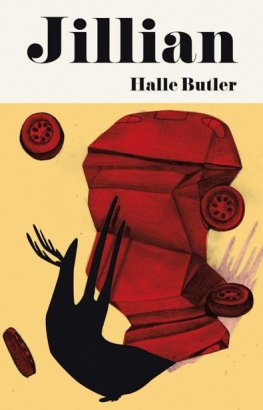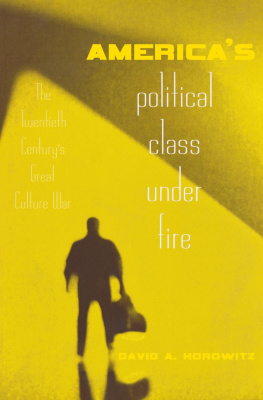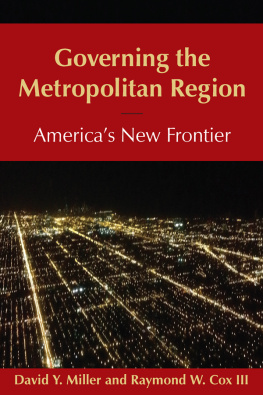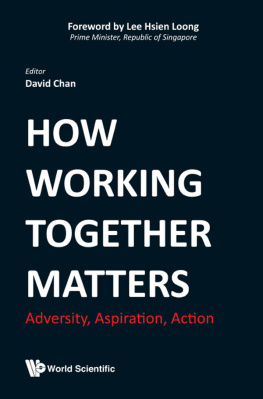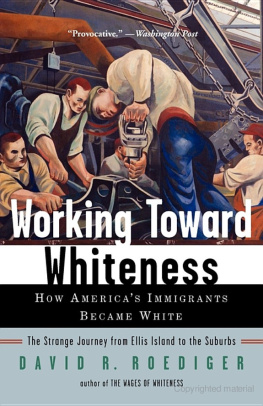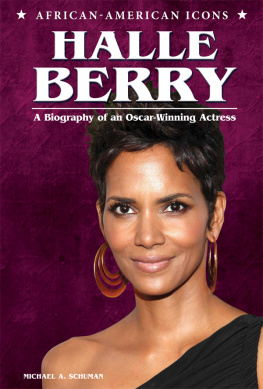The University of Chicago Press, Chicago 60637
The University of Chicago Press, Ltd., London
1984 by The University of Chicago
All rights reserved. Published 1984
Paperback edition 1987
Printed in the United States of America
96 6 5 4
ISBN 978-0-226-22936-2 (e-book)
Library of Congress Cataloging in Publication Data
Halle, David.
Americas working man.
Bibliography: p.
Includes index.
1. Chemical workersNew Jersey. 2. Labor and laboring classesUnited States 3. Social classesUnited States. 4. Class consciousnessUnited States. I. Title.
HD8039.C46U624 1984 305.5'62'0973 842566
ISBN 0226313654 (cloth)
ISBN 0226313662 (paper)
AMERICAS WORKING MAN
Work, Home, and Politics among Blue-Collar Property Owners
David Halle
The University of Chicago Press
Chicago and London
To Carla and Ritchie and the memory of Nicos
Contents
Acknowledgments
Among the industrial working class there is a special kind of warmth and friendliness. My major debt is to the men and their wives whose willingness to let me share their lives, and whose kindness and sense of fun, made this research so enjoyable. I am also grateful to local and regional officers of the Oil, Chemical and Atomic Workers Union, who gave me whatever assistance I asked for, and to the management of Imperium Chemical Company, who permitted me to carry out my study without limits or conditions and treated me with unfailing courtesy.
In the Sociology Department at Columbia I wish particularly to thank Herbert Gans and Allan Silver. Each was generous with his time and knowledge and posed challenging questions that helped me see the material in new and stimulating ways. William Kornblums support and encouragement were invaluable, as was his rich knowledge of blue-collar life. At the start of this research I obtained valuable advice from James Kuhn, B.J. Widick, Eli Ginzberg, and Ivar Berg in the Business School at Columbia. I also received help from Bogden Denitch, Andrew Beveridge, and Conrad Arensberg. To Steven Lukes, my first sociology teacher, I owe a special debt.
Jeanie Attie and Robert Zussman read the manuscript at various stages of its evolution and offered thoughtful comments and critical insight. I am grateful to many other friends and colleagues for their helpTracy Bolce, Adam Broner, Steve Cohen, Tom DiPrete, Helena Flam, Naomi Gerstel, Abby Ginzberg, Barry Goldberg, Susan Gray, Arno Gruen, Geoffrey Kabat, Mimi Lamb, Marian Landa, Mary Clare Lennon, Louise Mirrer, Stephen Mitchell, Mary Morris, Michael Navas, Kathy Nelson, Clara Rodriguez, Bernice Rogowitz, Peter Schneider, Gel Stevenson, and Nina Swidler.
Anyone needing creative artwork is fortunate to live in New York City. I received the help of several talented people. Brian Lav took all the photographs, with the following exceptions: .
None of the people depicted in the photographs are among the subjects of the research, and their identities are unknown to me.
Introduction
The largest oil refinery on the East Coast lies between residential sections of the cities of Elizabeth and Linden, New Jersey. Owned by Exxon, it occupies two square miles, an extravagant space for an urban area. A series of slender distillation columns push upward to the sky; below are squat, round storage tanks. So as not to absorb heat from the sun, the metal is painted in cool pastelslight blues and silver, pale yellow and pink and faded green. Tanks and cylinders are linked by pipes that twist and weave in graceful curves and angles. Mushrooms of steam spurt from vents in the ground, then drift and quickly disappear.
Nearby are several chemical plants. The space each occupies, a fraction of that taken by the refinery, is a jumble of cylinders and tanks, packed together like jars and bottles on a dressing table. These plantsEngelhard, Allied, Purepac, Apexline the New Jersey Turnpike, for northern New Jersey contains one of the densest concentrations of chemical production in the world. Along the highway swish plump tank cars carrying raw materials and finished products. The air smells slightly acrid, for chemical plants and oil refineries give off a steady stream of noxious vapors that are often invisible but leave clear odors. Most people who live in the area no longer notice the standard smell, picking up only the unusual.
This book is a study of the entire blue-collar labor force of one of these chemical plants, Imperium Oil and Chemicals. It aims to present a total picture of workers livestheir jobs, family relations and leisure activities, values and ideology, and their views on religion, ethnicity, politics, and social class.
One question has long dominated discussion of the working class in advanced industrial societies. How far are blue-collar workers middle class or bourgeois? This debate ranges over all aspects of working-class life and beliefs. There is an income debate, in which an image of affluent blue-collar workers
This book addresses all the debates just mentioned, which may seem rash. But in a way it is easier to consider all these questions than a few, since many of them are interdependent. For instance, if workers leisure and family lives are marred because the dull nature of blue-collar jobs leaves them mentally drained, then it is important to study life both at work and at home. Or consider the question of the American workers image of the class structure. Those who argue that image is a graded hierarchy without clear class distinctions tend to stress the impact of factors outside work, such as income level, consumer goods, and residential setting, while those who insist there is a form of class solidarity usually imply that this originates in the work experience.
There is an obvious need for studies that situate the views of blue-collar workers in the context of their entire lives. Yet our knowledge of the working class is fragmented. Most of the best ethnographies deal either with work or with life outside work. Few studies follow the same group of employees at and away from their jobs. In addition, a number of studies deal with only one stage in the life cycle, for they focus on married workers with young children. This is the time when economic problems are likely to be most severe; there are children to support, and often the wife stays at home to care for them and so cannot take a paid job. The presence of young children also seriously curtails the couples leisure time. Thus to consider only workers with young children is to risk mistaking one stage of the marital and life cycle for the essence of blue-collar life.
Studying part of the picture permits great richness and detail. Yet studies of the whole are also important, for it is only in such a context that the parts can be fully understood. As Norbert Elias put it: Human beings do not consist of separate and independent compartments. What has been taken to pieces for purposes of study, for purposes of study has to be put together again. That is why this book tries to present a complete picture of the lives of the workers it analyzes.
Many previous studies have handled the question of how far the working class is middle class by comparing current blue-collar workers with a picture of the working class in the pastthe traditional working class. Has the working class
This raises a related problem. The middle class is not a uniform group but consists of various sectors, an occupational salad in the words of C. Wright Mills. Thus the question of how far blue-collar workers are middle class becomes here the question of how far their lives and beliefs overlap with those of the upper- and lower-white-collar sectors.


